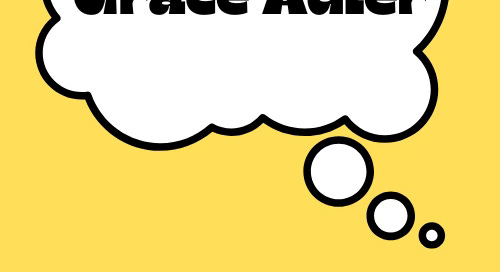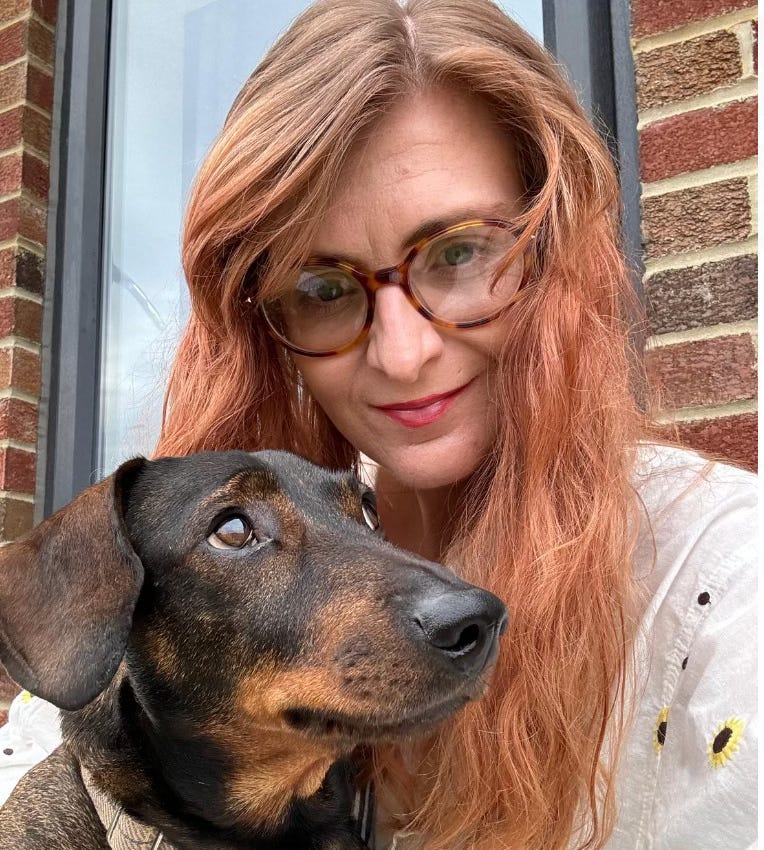Entry #1: Rachel Charlton-Dailey on Grace Adler
Janet Mitchell to Grace Adler—the disability representation that made a northern millennial.
There’s something about talking to Rachel Charlton-Dailey, and there is something about being northern—we’re the salt of the earth who can go a bit scorched earth if you don’t get straight to the point. It is a friendship built over the years through voice notes; “shy bairns get nowt,” and “man…” said and written, so you feel that pause and its weight. My own, mate, said with varying tones and emphasis. I have learned, as every northerner has, to infuse mate with a thousand different meanings—if I don’t call you mate three times in a conversation, I don’t much like you.
For all our accomplishments, education and experience, we’re just getting on with it—fussed, but not that fussed.
As a starting point. I wanted each person to write a little of their biography in their own words, so here’s Rachel’s answer unedited:
“I’m a disability rights activist, journalist and author from North East England. I’m multiply disabled and get about with a cane or a rollator. When I’m not writing, I spend my time running around after my sausage dog Rusty.”
Most days, voice notes have Rusty in the background and in writing about life, accomplishments, awards, and TV appearances—it’s that which cuts through.
That’s what I wanted this project to be—an up-close and personal experience. I also wanted to capture the vulnerability and the imperfection of these conversations.
We talk about being strong disabled women and strong disabled people—the stateliness and sternliness of that image. But we rarely talk about what it takes to get us there—holding it down until we get to the other side.
What of that up close, staring-you-right-in-the-face personal experience?
Because woah, that transition, especially, in my opinion, as a working-class disabled child, takes years, decades, it hurts—it’s messy.
Rachel’s choice of a “favourite” disabled character for this interview was Grace Adler (Debra Messing), from Will & Grace. Not a character traditionally considered to have ADHD. But I was struck by the hard truths it unravelled—it made perfect, imperfect, sense.
Will & Grace is a sitcom that initially ran between 1998 and 2006. It’s about the friendship between gay lawyer Will and Grace, a successful interior designer. Grace often has a scattered focus, is impulsive, and tends to multitask, which may suggest ADHD traits. Her frequent experience of distraction and forgetfulness while managing her busy life may have been used to comedic effect but could also read as undiagnosed ADHD.
Dr Russell A. Barkley, PhD, an internationally recognised authority on the condition, tells me that such "personal anecdotes" can be an important way to "add texture and understanding to the science of ADHD."
For generations, disabled people have had to hand-make positive, imperfect representations for themselves, and Grace made Rachel them feel “seen.” Rachel notes, “I’ve always massively identified with her.” Isn’t that what we need, to feel someone gets it as we go through it? As she continues:
“She exudes ADHD energy. She’s rash, chaotic, and indecisive but also sharp as a tack, shrewd, and creative, and her joy is infectious.”
We’re so often unafraid to talk about our disabilities now.
But, of course, it took both of us a while to get here. How could we clearly see ourselves, our bodies, and our perspectives? When we were raised in an environment that inflicted such ordinary-feeling harm?
Rachel recounts her first experience of disability on screen:
“My earliest memory on TV isn’t a good one; it’s when Honey Mitchell in Eastenders found out her daughter Janet had Down syndrome. The storyline completely centred the poor non-disabled parents who had been burdened with a disabled baby, it was even sympathetic towards her wanting to smother her child and putting her up for adoption. Janet was born in 2006 when I was newly disabled and trying to adapt to a life which heavily relied on the support of my family and parents. I was 17 at the time and already struggling with the feeling of being a burden to my parents. This storyline made me feel so much worse.”
That’s the truth—the negative gets into our sinews and synapses. Pushes us down.
As Rachel then wrote in their column for The Canary:
“This week, a friend asked me what the first defining moment of seeing disability portrayed on TV was for me – and it was something that brought back complicated feelings.”
The opinion piece continues:
“I can’t tell you the horrendous effect of seeing the way a parent of a disabled child was portrayed affected me as I grew up.”
Before continuing to state that the story might seem random and out of place, it isn’t.
These are the slowly moving parts of it all.
These aren’t nice, clean little paragraphs. They thrum and pulsate with pain inflicted years ago—and still felt.
With vulnerability and imperfection.
Hardly acknowledged.
This is what Dr Kirsty Liddiard of the University of Sheffield spoke of in her earlier introductory definition of disability representation:
“We have a long history of our experiences being misrepresented, which has, and continues to be, harmful in many different ways.”
I use a phrase: going full (Barbara) Lisicki—a reference to the disability rights activist.
I say it because, as disabled women, we have to find that place; our skin can’t be too thin, don’t be soft—no fleshy bits.
The media and others have to look us right in the eye—and take some responsibility for that truth.
According to a BBC article published in 2006, several organisations and charities were involved in putting together that storyline.
The charity mentioned was the Down's Syndrome Association. But, how had their feelings about the storyline changed in nineteen years?
I am grateful for this response:
“The original storyline was based on a true story and reflected the experiences of some people at the time. The Down’s Syndrome Association (DSA) was involved in an advisory capacity with the storyline, and we helped the producers find the baby, Grace (Janet Mitchell), who continues to star in the programme. Grace is an Ambassador for the DSA and attends our events, such as our annual My Perspective photography competition awards evening.
Since the programme aired 19 years ago, the DSA has engaged in several important projects with the NHS to improve staff training and the information provided to parents. Our Tell it Right training for midwives and Listen Include Respect training with Integrated Care Boards have been well received. We work on various boards and advisory committees relating to maternity care in England and Wales, and we have also made significant contributions to the NHS literature provided to expectant mothers. One standout example is the co-produced video on the NHS website about Down syndrome, which provides relatable and accessible information about life with a child who has Down’s syndrome.
We believe that storylines about Down’s syndrome in mainstream media are important mechanisms that can help raise awareness and bring about positive change. There are still improvements to be made, and we are committed to continuing our work with the NHS and health professionals to achieve these changes together.”
- Carol Boys, Chief Executive
I wanted to include every word of the reply because it shows some of the changes in disability representation—still imperfect but more thoughtful and aware.
It also shows the value of dragging stuff out of the archives, forcing ourselves to look even as we feel that instinctive pullback. It’s not always pretty, clean, pristine, but these are constructive, hard, heavy conversations.
This is the value in saying, actually, this hurt. This scraped the skin off my knuckles, and this broke something inside me, cut something out of me.
That is the up close, staring-you-right-in-the-face personal experience.
If you found this valuable, please consider Restacking it so more people can see it.





